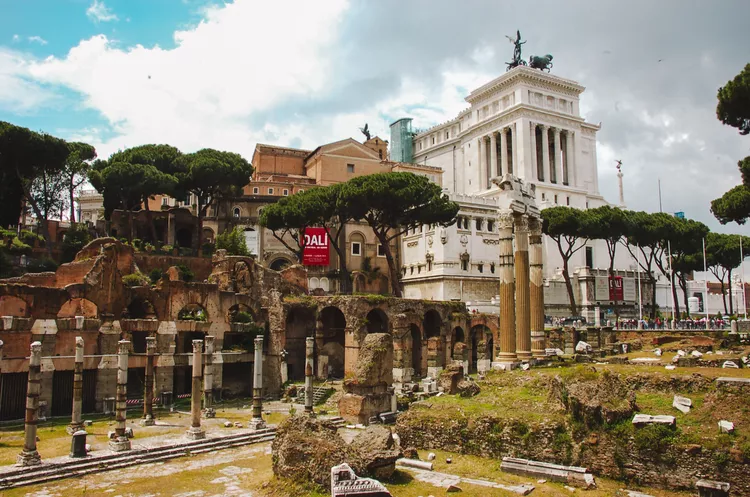Visiting the Ancient Forum in Rome
Top Sights at the Roman Forum
The Roman Forum is one of Rome’s most important attractions. It is a remarkable site filled with marble fragments, triumphal arches, temple ruins, and various other ancient architectural elements that date back to different periods in history. This overview of some of the Forum’s most notable attractions proceeds from east to west, starting at the Colosseum. To better understand the layout of the ruins, refer to this map of the Roman Forum.
Arch of Constantine – This massive triumphal arch is situated at the Piazza del Colosseo, directly outside of the ancient amphitheater. The arch was dedicated to Constantine in 315 A.D. to celebrate his victory over co-emperor Maxentius at the Milvian Bridge in 312 A.D.
Via Sacra – Many of the Forum’s significant buildings are aligned along the Via Sacra, the ancient triumphal “sacred” road.
Temple of Venus and Rome – As Rome’s largest temple, dedicated to the goddesses of Venus and Rome, it was constructed by Emperor Hadrian in 135 A.D. Perched on a prominent hill near the Forum entrance, it remains inaccessible to tourists. The best views of the temple ruins can be taken from inside the Colosseum.
Arch of Titus – Built in 82 A.D. to honor Titus’s victory over Jerusalem in 70 A.D., this arch features depictions of the treasures of Rome’s conquest, including a menorah and altar. It underwent restoration in 1821 by Giuseppe Valadier, who included an inscription that details this restoration and utilized darker travertine marble to distinguish between the ancient and modern sections of the arch.
Basilica of Maxentius – Once a colossal basilica, only the northern aisle remains. Although Emperor Maxentius initiated its construction, Constantine completed the basilica. This site is also known as the Basilica of Constantine. The great exterior of the basilica forms part of a wall along the Via dei Fori Imperiali, adorned with maps illustrating the expansion of the Roman Empire.
Temple of Vesta – A small shrine dedicated to the goddess Vesta, constructed in the 4th century AD and partially restored in the early 20th century. This shrine housed an eternal flame for the goddess of the hearth, Vesta, tended by the Vestal Virgins who lived adjacent to the shrine.
House of the Vestal Virgins – This location includes the remains of the residence where the priestesses managed the flame in the Temple of Vesta. Surrounded by a couple of rectangular ponds are around a dozen statues, many of which are headless, depicting some of the high priestesses from the Vestal cult.
Temple of Castor and Pollux – The twin sons of the god Jupiter were worshipped here since the 5th century B.C. The ruins that remain today date back to 6 A.D.
Temple of Julius Caesar – Only a few remnants of this temple remain, built by Augustus to mark the site where his Great Uncle’s body was cremated.
Basilica Julia – Fragmented stairs, columns, and pedestals are all that remain from Julius Caesar’s grand basilica, which served as a repository for legal documents.
Basilica Aemiia – Situated just within one of the Forum’s entrances at the intersection of Via dei Fori Imperiali and Largo Romolo e Remo, this basilica was constructed in 179 B.C. It was employed for money lending and as a meeting venue for politicians and tax collectors. Unfortunately, it was demolished by the Ostrogoths during the Sack of Rome in 410 A.D.
Curia – The Curia, one of the most historic structures within the Forum, served as the meeting place for Rome’s Senators. Originally constructed, destroyed, and rebuilt several times, the existing structure is a replica of one built by Domitian in the 3rd century A.D.
Rostra – Mark Antony famously delivered the speech beginning with “Friends, Romans, Countrymen” from this ancient platform after Julius Caesar’s assassination in 44 B.C.
Arch of Septimius Severus – This impressive triumphal arch at the Forum’s western end was constructed in 203 A.D. to honor Emperor Septimius Severus’s decade in power.
Temple of Saturn – Eight columns are still standing from this grand temple dedicated to the god Saturn, located near the Capitoline Hill section of the Forum. Archaeologists suggest that a shrine to the god has existed in this area since the 5th century B.C.; however, the iconic ruins visible today date from the 4th century A.D. The set of three columns that seem to float next to the Temple of Saturn belong to the Temple of Vespasian.
Column of Phocas – Erected in 608 A.D. in honor of the Byzantine Emperor Phocas, this solitary column is one of the last monuments added to the Roman Forum.





